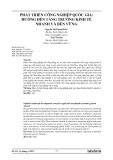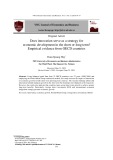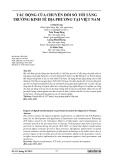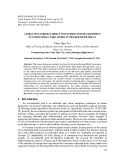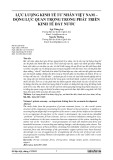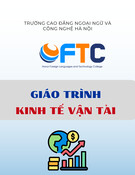
JSTPM Vol 13, No 3+4, 2024 1
THE EUROPEAN UNION’S SCIENCE, TECHNOLOGY
AND INNOVATION DEVELOPMENT POLICY TO RESPOND
TO THE CHALLENGES OF THE NEW CONTEXT
Hoa Huu Cuong
1
Institute for European Studies
Summary:
In the context of a rapidly changing world due to global challenges such as the COVID pandemic,
geopolitical competition among major powers, the Russia-Ukraine conflict, and, especially, the
explosion of the Fourth Industrial Revolution has greatly affected the development of countries
and regions around the world. Meanwhile, the European Union (EU) is lacking the motivation to
innovate and facing many environmental and social challenges. In addition, the EU is lagging
behind other countries, specifically: Losing to the United States in knowledge-based industries
and the number of high-tech human resources; Being surpassed by Japan and South Korea in the
high-tech product market; Facing great competitive pressure from China and India, which have
increased in high-value-added industries based on cheap human resources. Recognizing this new
context, the EU has implemented many measures to develop science, technology and innovation
(STI). The EU's experience is a valuable suggestion for Vietnam in its implementation of STI
development policies.
Keywords: Science and Technology; Innovation; Policy.
Code: 24102101
1. Introduction
In the current context, where numerous factors are influencing national
development goals, countries - particularly those in developed regions such
as the EU - are increasingly relying on the driving force of science,
technology and innovation (STI) to achieve these goals. Among these, STI
development policy plays a fundamental role. The EU's experience in
implementing STI policies in this challenging global environment will offer
valuable lessons for Vietnam in building and implementing policies to
promote STI, thereby contributing to the national development process.
2. Identifying some factors of the new context that affect the development
of STI in the EU
Currently, the EU is facing challenges stemming from both international and
internal factors. These factors have had certain impacts on the EU’s
development process, particularly in the field of STI, specifically:
1
Author’s contact: cuongeu25@gmail.com

2 The EU’s science, technology and innovation development policy…
2.1. International context
- The Fourth Industrial Revolution is having a profound impact on the EU’s
STI. Advanced technologies such as artificial intelligence (AI), big data,
autonomous robots, the Internet of Things (IoT), and blockchain are not
only changing the way EU countries produce and consume but also
reshaping the processes of research and innovation, creating new
opportunities and major challenges for EU technology and innovation
policies.
- The Russia-Ukraine conflict has had a strong impact on the EU’s STI
development strategies. These impacts include increased spending on
defense and cybersecurity, adjustments to technology supply chains,
changes in the direction of international cooperation in research, and
increases in clean and sustainable technology initiatives. Despite these
challenges, the conflict also opens opportunities for the EU to increase its
autonomy and innovation in key technology areas.
- Geopolitical competition among major powers, particularly between major
countries such as the US, China, Russia, and emerging economies, has a
profound impact on the EU's STI. This not only creates challenges in
maintaining global competition in high-tech sectors but also pushes the EU
to adjust its technology and research policies to reduce dependence on
other countries and protect its interests in strategic technologies. Despite
many challenges, this competition also opens opportunities for the EU to
increase investment in innovation.
- The COVID-19 pandemic has significantly accelerated innovation and
digital transformation in the EU, particularly in healthcare, digital
technology, and sustainable manufacturing. However, it has also created a
series of challenges, including supply chain disruptions, heightened
cybersecurity concerns, and the need to upgrade the digital skills of the
workforce. The EU has used the pandemic as an opportunity to drive
innovation, advance digital transformation, and build a more sustainable
and secure digital economy.
- Climate change also has a profound impact on the EU’s STI, driving
innovation in areas such as renewable energy, low-emission technologies,
sustainable agriculture, and smart cities. At the same time, it also poses
major challenges for industries and supply chains. However, through
international cooperation, scientific research, and investment in new
technologies, the EU is leveraging STI to address these challenges and
create a sustainable future.
2.2. Regional context
- The EU’s lagging behind major competitors such as the United States,
China, and other Asian countries in STI is a growing concern. While the

JSTPM Vol 13, No 3+4, 2024 3
EU remains strong in many areas such as renewable energy,
pharmaceuticals, and environmental technology, it faces challenges in
maintaining and enhancing its STI position amid significant disruption
from other economies.
- Population aging presents challenges and opportunities for the EU’s STI
policy. While aging may create problems for the workforce and R&D
spending, it also drives the development of technologies and services for
older people, and it requires innovation policies focused on assistive and
automated technologies. To stay competitive, the EU has increased
investment in strategic areas such as medical technology, elderly care,
automation, and workforce retraining.
- The EU Green Deal is not only an environmental protection strategy but
also a major driver for the strong development of STI. By investing in
clean technologies, renewable energy, green transport, smart
manufacturing, and sustainable business models, the EU is opening great
opportunities for innovation and sustainable economic development. EU
countries and businesses must seize this opportunity to foster technological
advancements while contributing to reducing greenhouse gas emissions.
3. European science, technology and innovation development policy
3.1. Objectives and targets of the policy
3.1.1. Objectives
Throughout its history, the EU's STI development policies have undergone a
major change from focusing on cooperation in basic science to aiming at
developing a knowledge-based economy, and in the current context, the goal
of the EU's STI development policies is to create a sustainable and digital
economy. These changes reflect the EU's sensitivity in adapting to global
challenges while leveraging STI to drive economic growth, improve living
standards, and protect the environment.
3.1.2. Policy Targets
The history of the development of the EU's STI policy shows that there have
been changes in the target audience of the policy, specifically: before 2010,
the EU's STI development policies focused mainly on research institutes and
universities. Since 2010, the EU's STI development policies have expanded
include a diverse range of stakeholders, including small and medium
enterprises (SMEs), universities, research institutes, the public sector,
industry, consumers, and the social community.
3.2. EU’s STI Development Tools and Measures
3.2.1. Reforming the appropriate environment for STI development

4 The EU’s science, technology and innovation development policy…
To develop STIs in the current context, the EU has reformed its environment
to better support STI development, specifically by:
Implementing new legal tools
- The General Data Protection Regulation (GDPR), which came into effect
in May 2018, has created a unified legal framework to protect the privacy
and management of personal data for EU citizens. GDPR requires
companies to notify about the collection and use of data and request
explicit consent from users. Strict security measures and the requirement
to report data breaches within 72 hours of detection are also important
elements of GDPR. Companies that do not comply can be fined up to 20
million EUR or 4% of their total annual global turnover. The GDPR not
only protects EU citizens but also sets a global standard for data protection
(European Parliament, 2016);
- The Artificial Intelligence Act (AI Act): proposed in April 2021 and
completed by the end of 2023, sets out the world's first legal framework
for artificial intelligence (AI). To ensure compliance, each EU member
state will establish an AI supervisory authority, and a European AI Council
will coordinate and monitor enforcement, with fines of up to €20 million
or 4% of the global turnover of the offending company (European
Parliament, 2024);
- The Data Act (Data Act): proposed in February 2022, is a key part of the
EU's data strategy, aiming to create a single data market and develop the
efficient use of data across the region. The Act also supports
interoperability and data portability between different systems and
providers, making it easier for users to switch services and ensuring that
data can be used continuously without technical obstacles (Federico
Casolari et al, 2023);
- The Cybersecurity Act (CSA): proposed in September 2022, is an important
step towards ensuring the security of digital products such as software and
hardware. The CSA requires manufacturers to integrate cybersecurity
measures into all stages of the product lifecycle, from design and
development to maintenance. Manufacturers must promptly report
security vulnerabilities and cybersecurity incidents, increasing
transparency and safety for users (Jennie Clarke, 2024);
- EU Digital Services Regulations, including The Digital Services Act
(DSA) focus on creating a safer online environment by imposing strict
liability and accountability rules on online platforms. The DSA requires
these platforms to protect users from illegal content, disinformation, and
other online abuses (EBU,2023). The Digital Markets Act (DMA) aims to
maintain fair competition and prevent monopolistic practices by large
digital platforms, often referred to as “gatekeepers”. The DMA sets rules
to prevent companies from abusing their dominant position to eliminate or

JSTPM Vol 13, No 3+4, 2024 5
weaken smaller competitors. This includes measures such as banning
exclusive agreements and requiring equal access to services and data for
competitors and users (Jones Day, 2022);
- Cybersecurity regulation: aims to improve cybersecurity and the ability to
respond to cyber threats, ensuring the safety of critical infrastructure and
citizens' data. One of the key initiatives in this policy is the Cybersecurity
Directive (NIS2 Directive), adopted in 2016 and updated in 2020. The
NIS2 Directive requires member states to establish national cyber security
agencies, improve cybersecurity capabilities, and develop cooperation
between member states and international organizations (European
Parliament, 2022).
Building a scientific advice mechanism: The European Commission (EC)
established the Scientific Advice Mechanism in 2014. At the outset of the
development of the scientific advice mechanism, the EC decided to establish
a High - Level Group of Scientific Advisors, which provides expert scientific
advice for decision-making. Following the establishment of the Main
Scientific Advisory Group, the EC established the European Academy of
Sciences Scientific Policy Advisory Group in December 2016. With financial
support from the Horizon 2020 research and innovation framework program,
based on the Alliance of the five largest European Academies of Sciences,
the role of the European Academy of Sciences Scientific Policy Advisory
Group is to provide independent, state-of-the-art scientific advice for EU
decisions (Europarl, 2016).
Providing STI policy support services in Member States: In March 2015, the
EU proposed the establishment of a policy support service around the STI
Framework (González, S.; Kubus, R.; Mascareñas, J, 2018). Providing
innovation policy guidance and practical support from the regional level to
Member States and countries participating in the Framework. This aims to
improve and enhance the level of STI decision-making in EU Member States
as a whole, as well as the performance of the STI system. Annually, through
the publication of the launching notice, the countries concerned propose their
specific wishes in improving STI policy design, policy implementation, and
improving the quality and efficiency of the innovation system. The EC has
established an expert group to provide policy support that implements three
types of services: The first type is to provide peer review and special support;
The second type is to provide a platform for mutual learning and experience
sharing for applicant countries voluntarily; The third type is follow-up
support for countries that have received policy support services.
Establish STI principles in decision-making and establish feedback
mechanisms on the effectiveness of the implementation of regulations. To
improve the effectiveness of decision-making in developing STI, the EU has
developed and implemented the “EU Innovation Principle” which means that
when the Commission prepares to implement new initiatives or plans and





